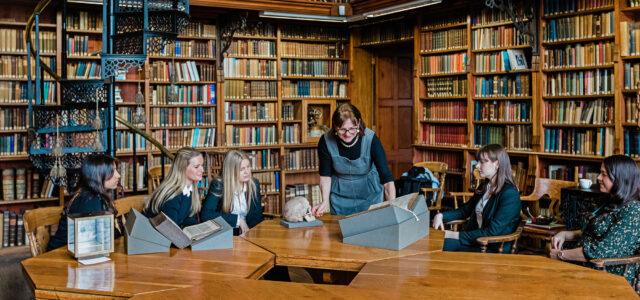
A Unique Way Of Learning
And Inspiring Young Minds
Within the walls of Stonyhurst College is the oldest museum in the English-speaking world, housing an extraordinary collection of prestigious, historical items.
There are more than 35,000 artefacts and 75,000 books, including Shakespeare’s rare 400-year-old First Folio, a South American caiman (alligator) donated by 19th century naturalist Charles Waterton, and a Holy Thorn that is believed to be part of the actual crown placed on Christ’s head.
Pupils on the Stonyhurst campus have access to these artefacts to bring their academic learning to life. Even the youngest Pre-Prep pupils have their imaginations fired by dinosaur fossils that they can see and touch, giving them a memorable early start to their academic journey.
The recent appointment of a Museum Education Officer, as a brand-new post, has enhanced this irreplaceable resource asset. Esther Rollinson, who was appointed in September 2023, previously worked as a Museum Volunteer at Stonyhurst as part of her PhD. “Seeing and researching items from the museum makes learning interesting and engaging. It’s a wonderful facility to have,” says Esther, who works alongside Stonyhurst’s long-standing Curator Dr Jan Graffius.
Together, they put this unique resource at the heart of pupils’ education: “We have been doing this for many years, but even more so since the museum was restored,” says Jan. “Artefacts from our collections enrich pupils’ knowledge as they can see and touch important items from history as part of the academic curriculum. Our Young Curators Programme enables them to learn curatorial skills, such as how to handle artefacts, how to look after them, and also how to label them, which really makes them think about the narrative behind each item.”
The restoration of the Historic Libraries and the creation of a new, award-winning museum, which opened in 2017, has made a huge difference to pupils and teachers. Artefacts are researched and chosen to facilitate object-based learning within the Stonyhurst curriculum – creating a unique, inspirational educational experience for pupils, helping them to both understand and appreciate their history.
Pupils were recently shown an 18th century ship’s lantern that had been cleverly designed so a candle stays upright even in high seas and storms: “They were fascinated by being able to hold the lantern and study it,” says Esther. “Many items like this are used as prompts for learning, which makes it so much more exciting for our pupils. The lantern was used in history and drama, as well as from an engineering perspective where pupils were encouraged to study the design and think about how it works.”
In the natural history collection is a 19th century seed from the Coco de Mer plant. Native to the south seas, it is the largest seed in the plant kingdom. “The seed looks like a modern sculpture and is becoming endangered,” continues Esther, “So this sparked a lesson focusing on conservation, the rain forests and the relationship between people and the environment.”
One of the major exhibitions held at Stonyhurst was the hugely successful Summer of Shakespeare, celebrating the 400th anniversary of the First Folio. This was open to the public during school holidays as well as visiting schools during term-time. “It was extremely enjoyable to put this exhibition together as I personally learnt so much,” says Jan, who chose relevant items from the museum to match with quotes from Shakespeare’s plays. “And I think it further emphasises the importance of Esther’s appointment in our ability to widen access to the museum and Historic Libraries for others. This is a collection for everyone and can completely transform their understanding of many different subjects.”
The College first started collecting objects in the late-16th century and one of the earliest items recorded was a cloth of gold and red velvet cope commissioned by Henry VII for Westminster Abbey in the late 15th century. The cope belongs to the British Jesuit Province and is on loan to Stonyhurst, where it is displayed as an illustration of the Jesuits’ long history as ‘keepers of Catholic memory’.
In 2021, the cope was one of a number of items lent to an exhibition at Hampton Court Palace. Stonyhurst has also lent artefacts to the V&A and the Tower of London, as well as museums internationally in the US and Europe. Jan, who travels with the items to ensure their safety, explains: “The more people have access to these items, the more interest it generates. It is fascinating that the artefacts cared for in the Stonyhurst collections are relevant to all levels of learning – from four-year-olds to research conducted by world-class academics.”
With a team of 26 volunteers, who carry out research and take guided tours, the Stonyhurst Museum and Historic Libraries have significantly boosted visitor numbers in recent years. “It’s not what we have, it’s why we have it and how we now use it,” concludes Jan. “Extraordinary objects have been donated over the years to be preserved, displayed and interpreted by each new generation as memorials to the past.”
This summer will give visitors a new chance to experience the Shakespeare Folio exhibition, through a fresh choice of artefacts linked to Shakespeare’s plays. This will be accompanied by an exploration of the issues surrounding the changing natural world, with much of this exhibition researched and curated by current Higher Line pupils.
Stonyhurst College
Clitheroe BB7 9PZ
01254 826345
stonyhurst.ac.uk

